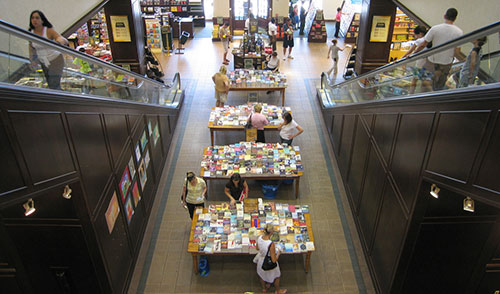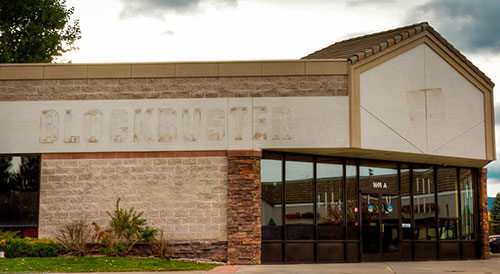We're Running Out of Widgets
What do Barnes & Noble, Radio Shack, and Blockbuster have in common? Simple: Their flawed business models relied on selling physical objects in stores.
Editor’s note: Apple’s revelation on Tuesday that it was rethinking its approach to stores into something akin to a “town square” got me thinking about an old piece I wrote a while back—one that I, ironically, was just interviewed about for Ozy. In lieu of a fresh one, here’s a lightly refreshed 2015 piece that still feels pretty relevant.
Sponsored By … You?
If you find weird or unusual topics like this super-fascinating, the best way to tell us is to give us a nod on Ko-Fi. It helps ensure that we can keep this machine moving, support outside writers, and bring on the tools to support our writing. (Also it’s heartening when someone chips in.)
We accept advertising, too! Check out this page to learn more.
6.6%
The decline in quarterly sales that Barnes & Noble—a company that sells a lot of books in a relaxed big-box environment—recently reported. While the company has managed to hold on a lot longer than many big-box bookstore chains of its type—in part because it tried to play Amazon’s electronic reader game by selling Nook devices—but it’s faced a lot of trouble competing. Nook had earnings of just $0.6 million in the most recent quarter, mainly as a result of cutting costs. Pushing physical products in a digital age, simply put, sucks.

(Pierre Metivier/Flickr)
Why Barnes & Noble should turn its stores into for-profit libraries
Barnes & Noble has a big problem—like many bookstores, it gives away its best product as long as you’re hanging out inside its big-box walls. In fact, those walls are kind of its selling point: Buy a coffee, get lost inside a book, maybe take it home with you.
But weaknesses in that model are leading some to question whether the company will survive its fight against Amazon, and even to speculation it might be sold off at some point.
But like the defunct Borders before it, it doesn’t make any money off of you sitting around dilly-daddling. That’s why Amazon is starting to win the war against specialized try-before-you-buy places like B&N and Best Buy: Once you know what you’re getting, why stick around?
Perhaps it’s because Barnes & Noble is in the wrong business. Instead of selling books, it should literally sell that experience. Barnes and Noble has a yearly membership program, but I’d like to propose that Barnes & Noble turn itself into a brick-and-mortar version of Spotify. Pay $20 a month, and you become a “member” of the bookstore: you get access to everything that’s inside for free, as long as you stay in the door. If you want to take a book home with you on a digital device, you can—but only one at a time so you’re not sucking the life out of the store. If you want to put that book on your shelf, the option remains available for you to buy it, but you’re by no means required to do so.
If this sounds basically the same as a library, it pretty much is, but there’s a big difference here: Your average library isn’t a for-profit corporation, but Barnes & Noble is. As a result, it has to work hard to convince the average person that paying $20 a month is a worthwhile investment.
The way they do that is by constantly making the experience that you find at its stores better by the day. It should continue to have that endless sea of books that it’s known for, but it should also focus on having employees who are better at recommending a good read than any algorithm. It should have events not every once in a while, but every day. They should buy more comfortable seats.
And they should find ways to encourage social engagement between people who go there—think book clubs, mentoring, and study buddies.
The problem with Barnes & Noble is that it aspires to be a “third space”—a place where people go when they’re not at work or home. However, because its ultimate business is selling books rather than one of life’s basic needs—food, water, or shelter–it’s not properly optimized to be a place where you can go when you don’t want to stay at home.
And as a result, the benefits of the competitive advantage fall by the wayside as the business gets disrupted, and when Barnes & Noble downsizes or goes out of business, an important community resource is lost.
What if, instead of monetizing the books, they monetized the important community resource? Amazon can’t beat that experience, no matter how many Kindles it sells.
“Life without community has produced, for many, a life style consisting mainly of a home-to-work-and-back-again shuttle. Social well-being and psychological health depend upon community. It is no coincidence that the ‘helping professions’ became a major industry in the United States as suburban planning helped destroy local public life and the community support it once lent.”
— Sociologist and public space advocate Ray Oldenburg, discussing the advantages of the “third space” in our society, which he argues have significant value as social centers, venues for democracy, and vital community elements. Oldenburg is one of the leading advocates of the “third space,” thanks to his authorship of the books The Great Good Place and Celebrating the Third Place.

(Dave Dugdale/Flickr)
How Blockbuster could’ve beat Netflix at its own game
To highlight the bigger point I’m getting at with that whole Barnes & Noble idea, let me throw another theoretical your way: Rather than shutting down its wide network of physical locations as its business model faltered, Blockbuster should have converted its old stores into tiny movie theaters.
Now, I’m not suggesting they should’ve taken their small-box buildings and turned them into giant multiplexes. But there was a big opportunity that the company missed by not seeing the potential of replacing the rows of DVDs and Xbox games with a half-dozen wide-screen TVs, some comfy couches, a couple consoles, and a small concession stand. The model would be simple to manage, wouldn’t cost a lot of money to convert, and—just like my theoretical for-profit library idea above—would monetize the experience, rather than the widget.
While Blockbuster could make money from selling food, the true secret sauce of this model is that it’s driven by a membership model. In this alternate scenario, Blockbuster would charge a monthly fee to its members for the promise of a wide selection of movies, killer sound, and the possibility of meeting new people.
The signs may say that these physical locations are “movie theaters,” but in reality, they’re “community centers.”
Now, you wouldn’t be required to go; if you wanted to stay home, you could get most (but not all) of the movies Blockbuster had available on your Apple TV, but this strategy would turn streaming into a perk, rather than the whole pie.
The reason this model has potential is twofold: First, as awesome as your living room is, the odds are pretty good that Blockbuster—having had deals with every major movie studio—probably can score a better selection of movies than you can, and can afford nicer furniture than you can. Second, it creates a physical social space at a time when face-to-face interaction is becoming more important to our society. And because Blockbuster locations generally were more common in your average city than a movie theater, odds are that if you were to make it a Blockbuster night, you’d be actually interacting with people that live in your neighborhood, rather than getting in a car for half an hour, watching a movie in a dark room—not interacting with anyone next to you—and then driving home.
The truth is, movies are a social experience. And that isn’t appreciated enough by the modern movie theater, which constantly shushes you for talking too loud. As much as Alamo Drafthouse hates it, there is in fact an audience that wants to talk and text during a movie—and Blockbuster would’ve been in just the spot to win that audience over.
And the economic model is a lot better, too: They may only get twelve people for a single showing, but those twelve people would be friends by the end of the film—and since Blockbuster already had their money anyway, it doesn’t matter if not every member shows up on a given day.
Membership is the thing that makes Netflix work; it could have been the thing that made Blockbuster work, had the company chosen to take advantage of all the brick and mortar it owned, turning it instead to competitive advantage over its digital-only rival.
And this idea translates effectively to a lot of other companies, too: Radio Shack shouldn’t have sold cell phones; it should have offered electronics instruction classes to its underserved root techie audience. Circuit City shouldn’t have sold disposable DVD alternatives; it should have figured out a way to get the movie buffs buying those DVDs talking to one another, sharing war stories about the home theaters they were building. Newspapers shouldn’t just sell newsprint; they should run event centers that allow for direct community interaction with journalists and newsmakers.
And the list goes on.
In a world where objects are becoming commodities, we should focus on building something that isn’t quite so easy to throw in a box and ship via FedEx. Communities and experiences are far harder to ship than any DVD.
What if our problem as a society is that we’ve failed to properly give value to experiences? Where we’ve allowed raw materials to drive the way that we live, even though it’s the social and emotional experiences of our lives that truly give them value?
The reason Radio Shack and Circuit City and Blockbuster and Borders and so many other companies in their position have failed is that they treated their relationship with the customer as a means to an end, with the end goal to sell you more stuff you don’t need. We ultimately go to these places to scratch an itch and fulfill an interest.
The reason why we’re so obsessed with our phones is that our favorite apps have figured out that we’re using them because we want to scratch an itch, not just buy a product. Social experiences scratch itches and build memories; stuff is just stuff with a limited shelf life.
The second a company loses sight of this is when their model is in danger of falling apart. Widgets matter less than why we want those widgets.
:format(jpeg)/2017/09/widgets--1--1.gif)
/2017/09/widgets--1--1.gif)


/uploads/ernie_crop.jpg)